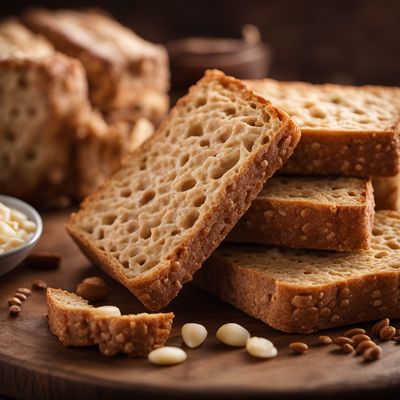
Ingredient
Bread and similar products
The Staple of Life: Bread and Similar Products
Bread and similar products encompass a wide range of baked goods made from flour, water, yeast, and other ingredients. They come in various shapes, sizes, and textures, ranging from soft and pillowy to dense and chewy. Bread is a versatile ingredient that can be used as a base for sandwiches, a side dish, or a vehicle for spreads and toppings.
Origins and history
The history of bread dates back thousands of years, with evidence of its consumption found in ancient civilizations such as Egypt and Mesopotamia. Over time, bread has evolved and diversified, reflecting the cultural and regional preferences of different societies. Today, bread is a staple food in many countries and plays a significant role in culinary traditions worldwide.
Nutritional information
The nutritional composition of bread can vary depending on the type and ingredients used. Generally, bread is a good source of carbohydrates, providing energy for the body. Whole grain breads are also rich in dietary fiber, vitamins, and minerals. However, it is important to note that some bread products may contain added sugars, preservatives, or other additives, so it is advisable to read labels and choose options with minimal processing and wholesome ingredients.
Allergens
Bread and similar products may contain allergens such as wheat, gluten, and yeast. Individuals with celiac disease or gluten sensitivity should opt for gluten-free bread alternatives. It is also important to be aware of potential cross-contamination in bakeries or facilities that handle allergenic ingredients.
How to select
When selecting bread, look for loaves that are fresh, with a golden-brown crust and a soft, springy interior. Avoid bread that appears stale, dry, or has a hard crust. For specialty breads, such as sourdough or artisanal varieties, consider the reputation and expertise of the bakery.
Storage recommendations
To maintain the freshness and quality of bread, store it in a cool, dry place, such as a bread box or a paper bag. Avoid storing bread in the refrigerator, as it can accelerate staling. If necessary, bread can be frozen to extend its shelf life. Sliced bread should be stored in a resealable bag or wrapped tightly in plastic wrap to prevent moisture loss.
How to produce
Producing bread at home requires basic baking skills and equipment, including an oven, mixing bowls, and measuring tools. There are numerous recipes and techniques available for different types of bread, ranging from simple sandwich loaves to intricate artisanal creations. Experimenting with different flours, flavors, and shapes can add a personal touch to homemade bread.
Preparation tips
Bread can be enjoyed in various ways, such as toasted with butter and jam for breakfast, used as a base for sandwiches, or served alongside soups and stews. It can also be transformed into breadcrumbs for coating meats or used as a binding agent in recipes. Get creative with different bread types and experiment with flavors and textures to elevate your culinary creations.
Culinary uses
Bread and similar products are widely used in cuisines around the world. They are a staple in Western diets, where they are commonly consumed as sandwiches, toast, or as an accompaniment to meals. Additionally, bread is an essential component of many traditional dishes, such as French baguettes, Italian focaccia, and Indian naan.
Availability
Global
More ingredients from this category

Crisp bread
"The Crunchy Delight: Exploring the World of Crisp Bread"

Bread alternative
Beyond the Loaf: Exploring Bread Alternatives

Additional bread products
Beyond the Loaf: Exploring Bread Varieties

Bread
"The Staple Sustenance: Unveiling the Secrets of Bread"

Rusk
"The Crunchy Delight: Unveiling the Secrets of Rusk"

Extruded, pressed or puffed bread
Airy Delights

Crackers and breadsticks
"Crispy Delights: Exploring the World of Crackers and Breadsticks"